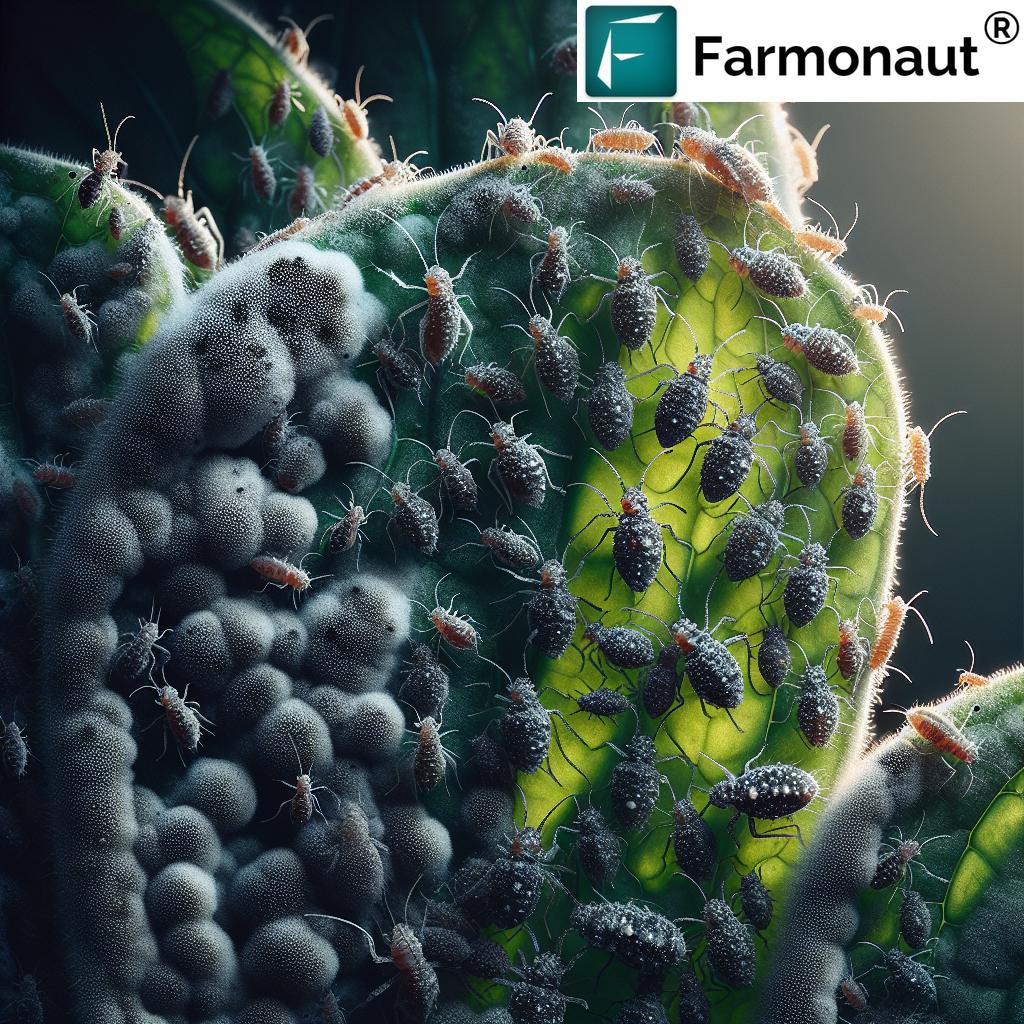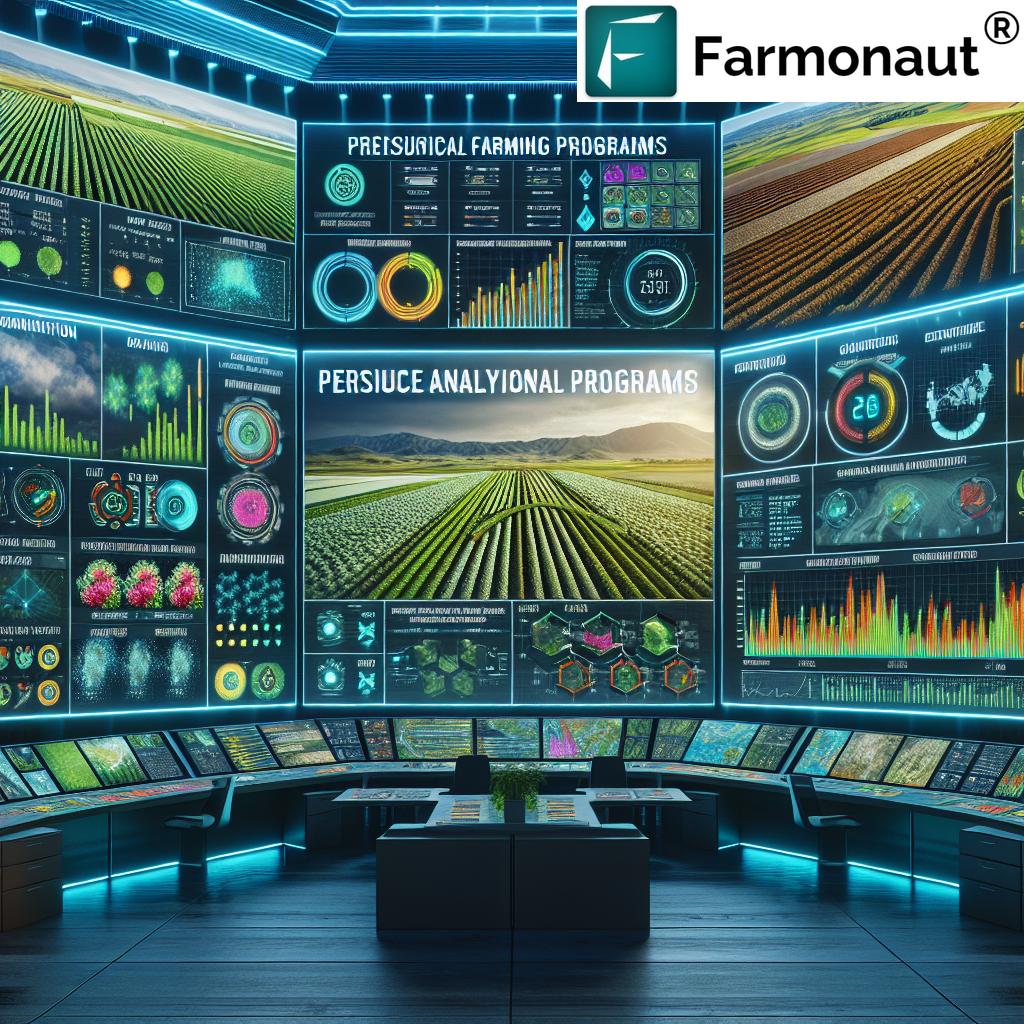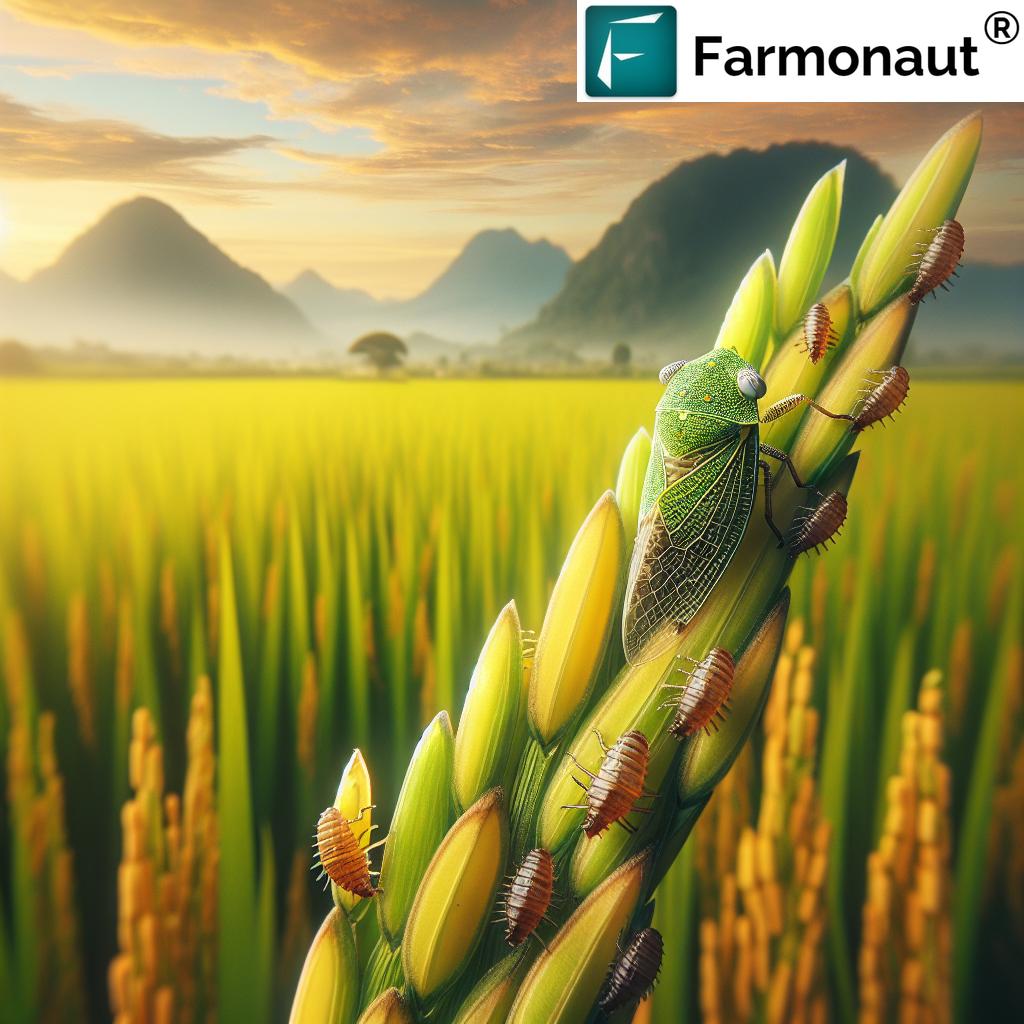Ontologies and Artificial Intelligence Systems for Smart Farming: How AI and Semantic Technologies Are Revolutionizing Cooperative Agricultural Ecosystems by 2025
Table of Contents
- Introduction: The Evolution of Smart Farming
- What Are Ontologies and AI Systems in Smart Farming?
- Semantic Interoperability: The Glue of Cooperative Smart Farming
- The Synergy of Ontologies and AI for Smart Farming
- Enabling Multistakeholder Collaboration and Cooperative Ecosystems
- Advancements in IoT and Edge Computing—Powering Real-Time AI & Ontologies
- Farmonaut’s Approach to Satellite-Driven, AI-Supported Smart Farming
- Comparative Impact Table: Traditional vs Ontologies & AI-Driven Smart Farming
- Challenges to Adoption: Standardization, Data, and Ethics in 2025
- Future Trends: What to Expect by 2025 and Beyond
- Frequently Asked Questions
“By 2025, over 70% of smart farming systems will integrate AI-driven ontologies for enhanced crop and resource management.”
Introduction: The Evolution of Smart Farming
The integration of ontologies and artificial intelligence systems for the cooperative smart farming ecosystem is rapidly transforming the global agricultural landscape. As we approach 2025, this technological synergy promises a future where efficient, sustainable, and collaborative agricultural practices are not just aspirational, but achievable realities. The pressure of growing population demands, climate change challenges, and resource constraints means that traditional farming models must evolve—leveraging the power of advanced data-driven technologies to ensure food security and environmental sustainability.
Ontologies—formalized, structured representations of agricultural knowledge—combined with AI-powered systems are enabling everything from climate-adaptive crop management to regional resource cooperation among farms. This new paradigm is giving rise to resilient, data-enabled, and precision-driven agricultural ecosystems where stakeholders collaborate seamlessly across a multitude of devices, sensors, and platforms.
In this comprehensive guide, we’ll explore the concepts, technologies, and revolutionary impact of ontologies and artificial intelligence systems within the context of cooperative smart farming by 2025. We’ll also discuss real-world advancements, including the Farmonaut approach to satellite-driven, AI-powered agriculture, all while ensuring you gain actionable knowledge, supported by the latest SEO guidelines and thoroughly engaging, keyword-optimized content.
What Are Ontologies and AI Systems in Smart Farming?
To understand the transformative force of ontologies and artificial intelligence systems for the cooperative smart farming ecosystem, we need to clarify the core building blocks of these technologies and how they enable smart, interconnected agricultural systems.
Defining Ontologies in the Agricultural Context
An ontology is a structured, formalized representation of knowledge within a specific domain. In smart farming, ontologies define concepts such as soil conditions, crop types, weather patterns, pest organisms, and more—including the relationships, properties, and attributes that connect them.
- Shared Vocabulary: Ontologies provide a common language for diverse devices, sensors, and AI systems, ensuring uniform understanding across heterogeneous platforms.
- Semantic Interoperability: They enable different agricultural software and hardware to communicate seamlessly — crucial when multiple farms, technology vendors, and regional agencies need to collaborate.
- Structuring Complex Knowledge: From fertilization strategies to regional weather adaptation, ontologies offer a framework for representing and reasoning about complex agricultural knowledge.

Artificial Intelligence Systems: Adaptive Decision-Making for Smart Farms
AI systems take raw, heterogeneous data—from soil sensors, weather stations, drones, and satellites—and transform it into actionable insight. By embedding ontological frameworks, AI can contextualize the information it receives, enabling:
- Machine Learning Algorithms: Learning from historical trends, satellite imagery, and real-time sensor data to predict yield projections.
- Expert Systems: Leveraging ontological relationships to provide suggestions for pest control and crop management.
- Predictive Models: Understanding causal relationships between soil health, crop growth, weather, and environmental conditions.
By 2025, the integration of ontologies and AI for smart farming will become essential for efficiency, sustainability, interoperability, and multi-actor cooperation across regional agricultural ecosystems.
Tip: Monitor your crops via AI and satellite imagery with Farmonaut’s advanced platform. 
Semantic Interoperability: The Glue of Cooperative Smart Farming
As regional agricultural demands intensify due to population growth and climate change, collaborative farming is gaining ground in 2025. At its core, this cooperation hinges on semantic interoperability—the capacity for devices, data sources, and autonomous agents from different backgrounds to understand and use shared contextualized knowledge.
- Multiple Devices & Platforms: Autonomous machinery, drones, tractors, remote sensors, and cloud-based solutions must interpret data semantics in a uniform way to execute complex tasks, such as coordinated sowing and irrigation.
- Essential for Integration: Without a shared ontological vocabulary, interoperability would break down, leading to fragmented and inefficient regional ecosystems.
Key Elements of Semantic Interoperability:
- Formalized Representations: Ensuring every data stream (soil moisture, temperature, pest levels, etc.) is strictly defined by protocols understood between systems.
- Contextualization: AI-powered systems use ontologies—contextualizing data for improved decision making and automated actions across regional entities.
- Collaborative Tasks: From pest-scouting drones to satellite weather analytics, semantic interoperability ensures coordinated, precision-guided actions in cooperative smart farming.
AI Advisory: Solutions like Jeevn AI deliver custom insights, integrating semantics from remote sensors and satellite data, enabling real-time, context-driven recommendations.
“AI ontologies enable smart farms to process up to 10x more agricultural data than traditional digital systems by 2025.”
The Synergy of Ontologies and AI for Smart Farming
The collaboration between ontologies and artificial intelligence systems is not merely technical—it is the engine powering today’s transformation of agricultural ecosystems into resilient, efficient, and data-rich frameworks.
Enabling Intelligent Decision-Making
- Data Interpretation: AI uses ontologies to contextualize data, recognizing, for example, how soil pH and local climate conditions impact specific crop varieties.
- Learning from Heterogeneous Data: Machine learning models analyze vast streams of sensor, drone, and satellite data, producing insights unattainable via human observation alone.
- Knowledge Integration: AI expert systems blend local, tacit farmer wisdom (modeled via ontologies) with scientific, sensor-based data, ensuring culturally sensitive, sustainable recommendations.
For example, AI algorithms might leverage a regional crop ontology to identify an emerging pest outbreak by correlating sensor signals, historical weather trends, and patterns in satellite imagery, then recommend optimized, precision-guided control measures.
Precision at Every Step
- Resource Optimization: Ontologies and AI work together to manage variable-rate irrigation, pesticide application, and fertilization, based on specific soil and crop conditions.
- Early Detection and Risk Management: AI-driven ontological models maximize early warning accuracy for infestation risks and climatic challenges.
The cooperative smart farming ecosystem is thus revolutionized by this synergy—empowering decision-makers with real-time, actionable knowledge and enhancing productivity, sustainability, and operational efficiency across global agriculture.
Enabling Multistakeholder Collaboration and Cooperative Ecosystems
Modern agriculture is no longer an isolated endeavor; farms are increasingly viewed as interconnected nodes within broader regional networks. This evolution places a premium on data sharing, coordinated strategies, and collaboration among stakeholders, including:
- Farmers
- Agronomists
- Government agencies
- Technology providers
- Financial institutions
How Ontologies Enable Cooperative Smart Farming
- Shared Data Models: Ensuring data exchanged between different farms, platforms, and regions is interpreted correctly and consistently.
- Collective Decision-Making: Ontologies, combined with AI, underpin regional water management, coordinated pest control, and synchronized harvesting—maximizing resource efficiency and resilience.
- Knowledge Equity: By encoding indigenous and local farming knowledge alongside scientific data, ontologies empower historically marginalized actors in the value chain.
For example, during regional droughts, ontologies can be used to coordinate and prioritize water allocation, ensuring fair access while AI optimizes irrigation based on real-time soil and weather conditions.
Blockchain-Enabled Traceability: Farmonaut’s traceability solution leverages ontologies and AI to provide transparent, semantically structured farm-to-fork tracking. This enhances trust, supports supply chain sustainability, and simplifies compliance for cooperative farming networks.
Advancements in IoT and Edge Computing—Powering Real-Time AI & Ontologies
By 2025, key technological advancements in IoT (Internet of Things) and edge computing are significantly amplifying the role of ontologies and artificial intelligence systems within cooperative smart farming ecosystems.
- Edge Computing: Processing AI-powered analytics and ontological reasoning directly at the farm—on local devices—not just in remote data centers. Increases system robustness and boosts real-time responsiveness during adverse events.
- IoT Devices: Deploying sensors and autonomous machinery that understand ontological frameworks, enabling a web of smart, communicating agents supporting real-time monitoring and automation.
Case Example: Variable-Rate Irrigation
When an IoT-based soil moisture sensor detects sudden dryness, its alert is semantically contextualized against weather and crop ontologies. AI then triggers only the precisely required irrigation action, maximizing efficiency and reducing waste.
Farmonaut’s Approach to Satellite-Driven, AI-Supported Smart Farming
As a pioneering satellite technology company, we at Farmonaut are facilitating the next generation of smart farming ecosystems by merging AI, machine learning, blockchain, and satellite imagery.
- Satellite-Based Monitoring: Our multispectral imagery reveals vegetation health (NDVI), soil conditions, and infrastructure status, enabling decision-makers to contextualize large-scale and regional data within ontological frameworks.
- AI Advisory: Jeevn AI delivers recommendations based on real-time crop conditions, weather analysis, and historical patterns.
- Resource Management & Traceability: Harnessing blockchain integration, we ensure transparency, trust, and validation for products and farm operations.
- Environmental Impact Monitoring: Carbon footprinting tools empower sustainable agricultural practices—aligning AI and semantics with regulatory and climate goals.
- Accessibility & Collaboration: Our platform is available on web, Android, and iOS, plus API for seamless integration with external systems (API, API Developer Docs).
Subscription Model: We offer affordable, scalable subscription packages for individuals, businesses, and institutions. See your personalized plan below:
Comparative Impact Table: Traditional vs Ontologies & AI-Driven Smart Farming
This table offers a clear, side-by-side view of the estimated benefits of deploying ontologies and artificial intelligence systems for the cooperative smart farming ecosystem by 2025—across major domains. It highlights efficiency, sustainability impact, and interoperability improvements vital for the next-generation agricultural landscape.
| Smart Farming Domain | Traditional Methods (Current State) | With Ontologies & AI (Projected 2025) | Estimated Efficiency Gain (%) | Sustainability Impact | Level of Interoperability |
|---|---|---|---|---|---|
| Crop Monitoring | Manual scouting; periodic reports; limited remote sensing | Continuous, real-time monitoring via AI-integrated satellite & sensor networks | +65% | High | High |
| Resource Management (Water, Fertilizer) |
Generalized schedules; inefficient application | Ontological models enable precision guidance for field-level, crop-specific needs | +70% | High | Medium-High |
| Pest & Disease Management | Reactive responses; slow identification; manual scouting | Proactive detection using AI deep learning mapped onto pest ontologies | +55% | Medium-High | High |
| Supply Chain Traceability | Paper trails; minimal digitalization; prone to error | Blockchain-enabled, semantically-referenced, end-to-end digital records | +60% | High | High |
| Environmental Monitoring | Intermittent, post-factum testing; scattered records | Continuous carbon footprinting, NDVI analysis, and compliance automation | +75% | High | High |
| Regional/Rural Cooperation | Isolated management; poor data sharing; siloed analytics | Unified, ontology-driven platforms facilitate multi-stakeholder decision-making | +50% | Medium-High | High |
Fleet Optimization: For agricultural organizations handling logistics and field equipment, our fleet management tools combine AI, idiosyncratic ontological models, and real-time satellite data for maximized equipment use and minimized losses.
Crop Loans and Insurance: Satellite-based risk verification is transforming how farmers access credit and insurance. Semantic models parse multi-modal data, slashing fraud and improving access for smallholders.
Carbon and Sustainability Monitoring: Farmonaut’s carbon footprinting tracks emissions from field to supply chain for climate-ready farming.
Challenges to Adoption: Standardization, Data, and Ethics in 2025
While the potential of ontologies and artificial intelligence systems for the cooperative smart farming ecosystem is vast, several critical challenges must be addressed to achieve universal scaling by 2025:
- Standardization Across Sectors: Diverse crops, weather conditions, and local practices require ongoing adaptation of ontologies. Global, open data initiatives are vital to ensure up-to-date, universally accepted frameworks.
- Ensuring AI Transparency & Fairness: AI models must remain transparent—stakeholders need to understand how decisions are made, reducing risks of bias.
- Data Security and Privacy: As collaboration and data exchange intensify, secure transfer and storage—especially across regional boundaries—are essential for trust.
- Empowering Farmers: Ethical AI adoption means ensuring humans, especially smallholders, retain agency over final decisions.
Collaborative Solutions Moving Forward
- Open-data initiatives for dynamic, region-specific ontologies
- Multi-stakeholder standards-setting processes
- Transparent algorithms and explainable AI
- Localized capacity building for farmers and agronomists
Future Trends: What to Expect by 2025 and Beyond
- AI Ontologies as Standard Farm Infrastructure: 70% of smart farms globally will use ontological AI systems for decision support, automation, and data exchange.
- Edge & Autonomous Operations: Nearly all major agricultural equipment will process semantic and AI analytics locally—cutting response times and boosting resilience.
- Cooperative, Regional Models: Farms will band together in data co-operatives, pooling knowledge for regional efficiency and adaptability using ontological standards.
- Environmental Sustainability: Carbon tracking, biodiversity modeling, and input optimization propelled by ontologies and AI will be the cornerstone of climate-neutral agriculture.
- Inclusive, Equitable AI: Efforts will grow to encode and elevate local knowledge, ensuring that the smart farming revolution benefits all—including smallholders and rural communities.
Conclusion: The Backbone of Next-Gen Smart Farming Ecosystems
By 2025, ontologies and artificial intelligence systems for the cooperative smart farming ecosystem will be the defining backbone for precision, sustainability, and collaboration. Semantic interoperability, AI-driven data streams, and multi-stakeholder cooperation are converging to produce a robust, adaptive agricultural landscape—one capable of addressing climate challenges, resource constraints, and evolving global demands.
For forward-looking stakeholders, the road ahead is clear: integrate ontologies and AI within farm operations and regional ecosystems, prioritize interoperability and inclusivity, and harness advanced solutions like Farmonaut’s platform to drive productivity, resilience, and sustainability.
Empower your agricultural journey with semantic AI and satellite insights—build the cooperative, data-driven smart farm ecosystem of tomorrow.
Frequently Asked Questions
1. What is an ontology in smart farming?
An ontology in smart farming is a structured, formal representation that defines key agricultural concepts, relationships, and properties (such as soil types, crop growth stages, weather events, and pest organisms). Ontologies provide a shared vocabulary and semantic framework that allows different digital systems, devices, and stakeholders to interpret and exchange information uniformly, enabling semantic interoperability across the smart farming ecosystem.
2. How does artificial intelligence benefit modern agriculture?
Artificial intelligence systems gather, analyze, and interpret vast volumes of heterogeneous data from satellites, IoT sensors, and farm machinery. AI enables predictive analytics, optimized decision support (such as pest forecasting, resource allocation, and automation), and can integrate local knowledge—allowing for sustainable, efficient, and adaptive farming practices.
3. Why is semantic interoperability important in cooperative smart farming?
Semantic interoperability allows data and recommendations from different systems—such as sensors, autonomous machinery, and regional agencies—to be understood consistently. This forms the foundation for cooperative, multi-actor decision-making, improving productivity and resilience at both the farm and regional levels.
4. What does Farmonaut offer for smart farming ecosystems?
We at Farmonaut provide satellite-based monitoring, AI-driven advisory tools, blockchain-enabled product traceability, and carbon footprinting—all accessible via web, Android, iOS, and API. Our platform empowers individual farmers, businesses, and governments to leverage semantic and AI technologies for sustainable and efficient agricultural operations.
5. What are the biggest challenges in adopting ontologies and AI in farming?
Key challenges include standardizing ontologies across diverse regions and crops, ensuring AI model transparency and fairness, safeguarding data privacy, and providing equitable access to technology and decision support for all stakeholders—particularly smallholders.
6. How are ontologies and AI expected to evolve by 2025?
By 2025, ontologies and AI are expected to become core elements of farm infrastructure, enabling real-time automation, cooperative regional management, and seamless data exchange. These technologies will strengthen both productivity and environmental stewardship, helping address global food security and climate resilience.
Ready to experience the future of smart farming?
- Launch the Farmonaut Web & App platform for satellite-driven smart crop monitoring, AI advisory, and more.
-
For API integration and developer solutions, visit:
Farmonaut API and
Developer Docs -
Interested in traceability or sustainability? Explore:
Traceability Solutions and
Carbon Footprinting










